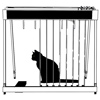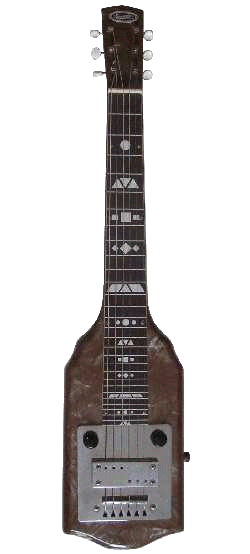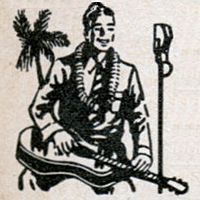Concerning Steel Guitar Tone
 Concerning
“tone,” there are many things to
consider. I recently read an awesome interview of Lloyd Green that really
got me thinking about my overall tone on steel guitar...
Concerning
“tone,” there are many things to
consider. I recently read an awesome interview of Lloyd Green that really
got me thinking about my overall tone on steel guitar...
I've been experimenting with my tone since and making improvements. There are so many factors involved in good tone. Here's an excellent Lloyd Green quote from the above interview...
“I could draw you a list of maybe fifty ingredients that go into getting tone. To me, it’s just simply the most important part of playing. Without tone, it’s all irrelevant...
The reason tone is so important is because I think ultimately that’s what is the emotional connection when you’re playing music to what people are hearing. If they hear good tone, there is something that strikes a resonant note in the soul. You can be playing the greatest stuff in the world, but if it doesn’t have good tone, there’s something that’s not making a connection.”
I love Lloyd's tone. His tone is always bright, sharp, crisp, clear; not muddied or drowned out with effects. I've learned a lot about tone over the years through trial and error (and by accident), and I've just begun to discover what I've been missing. Here's some more Helpful Advice For Steel Guitarists. My friend, CRANK IT UP! You've never discovered true tone until you've laid into your volume pedal at a higher volume on your steel guitar. This includes pedal and non-pedal steel guitars). Trust me, I know what I saying here, because for years I didn't even know what tone was until I heard myself performing at a higher volume.
Like Jeff Newman used to teach... Play what you
hear, and hear what you play! You'll never have a decent tone at low volume.
People love to hear me performing Hawaiian music through a MicroCube amp
with a 5" speaker at the beach, but the sweet tone is not there. It
frustrates me because I know I am not making the emotional connection with
the hearts of my listeners as I'd like to. I've heard songs that didn't move
me, although they were pretty; but then I broke down in tears when I heard
that same song played live by the band in public, because of one word...
TONE! I explain much more in my section titled,
Recording Your Steel Guitar.
Tube Amps Verses Solid States Amps
Here's some helpful information from the Fender company on tone in tube amps verses solid state amps...
Most musicians and studio technicians who use tube amplifiers do so because they love the warm, natural sound produced by tubes as opposed to solid state circuits, which can sound artificial or sterile to some. A tube amp will have more pleasing harmonic overtones than a solid state amp due to it's smoother transition into clipping ranges (overdrive). Tube amps also will sound louder than a solid state amp set at the same volume. Although technically solid state circuits have higher fidelity than tube circuits, lovers of tube amps swear that there is a huge difference in the quality of sound produced by all tube equipment. The tone that they produce is pretty much the only benefit, but it is obviously an important one when it comes to music. Oh, and there's also that really cool tube glow you get from a warm valve.
SOURCE: http://fenderbassplayer.com/tube-amps-vs-solid-state-amps
This is why both Lloyd Green and Jerry Byrd used the Fender Twin Reverb amplifier. You can't beat the tone of a tube amp. Truthfully, there are dozens and dozens of things that equate into good tone. But some of the basic key elements to tone are in your hands already; such as, playing louder so that people can hear your chords and enjoy the music. And as you play louder, you'll enjoy playing more, trust me. You already have a stainless-steel bar, so why nor work at adding vibrato throughout the song, as a means of expressing yourself. As Lloyd has said amongst good friends... He makes love to the instrument. Passion is the key word when playing pedal steel guitar, if that player is any good at all. If a steel guitarists pours his mind, heart and body into his performance, then he WILL have his own musical signature. Everyone has one, who has played long and hard enough to develop their own a distinctive sound.
So if you don't know anything about tone, I
recommend that you at least take your steel guitar down to a local music
store and ask to please perform through a Fender tube amp. It's a safe
investment to buy any of the popular steel equipment, as you can always sell
it if it doesn't float your boat. But I'd prefer not to take a loss and have
to keep playing musical-chairs before I find the amp I'm looking for. So I
think the best advice is to find which professional steel guitar player you
desire to play like, and then ask them what equipment they use. That makes
sense to me!
Sweet Vibrato
Also, a big part of creating tone is your bar
contacting the string. I've noticed that some of Lloyd's music that most
impacts my heart is when he uses a little vibrato. You can hear it in his
song, “Secret Love,”
on his Ten Shades Of Green album. At 20 minutes into the MP3 audio
clip, you can hear Lloyd use a nice amount of smooth vibrato to connect with
the audience/listener. This is what playing steel is all about, making that
connection with others. Anybody can just play a steel guitar, but if you'll
learn to incorporate the little traits of greatness into your songs, like
Lloyd uses, then you'll become a much better player. Listen to Lloyd tone
during the vibrato, and the perfect place in the song to add it. I love the
song.
Boss DD-3 Delay Pedal is an Absolute Must for Every Pedal Steel Guitarist
The one piece of equipment that every pedal
steel player absolutely must have is a Boss delay pedal. I have about three
Boss DD-3 pedals that I use, because I always keep two steel guitars set up.
I go back and forth between my wood body/wood neck D-10 Sho-Bud and my mica
with aluminum neck S-10 Rittenberry. I hate compressors pedals, because they
cut off your highs, which is what digital signal processing does. I like
Lloyd's pure sounding steel guitar, with the delay set to the tempo of the
particular song.
Learn To Focus Your Energy Into Your Music
Everyone has energy to varying degrees. What
gets my energy levels up is hearing Hawaiian and Country music, then I am
compelled to play for an hour or so if I can. When Lloyd plays, there is
energy. You can feel and hear it in his performance. Those bar bounces,
string attack, quick bar action, running scales and lots of expression—it
all makes Lloyd's performances unsurpassed. When I see a dry steel guitar
player, slouching in his chair, playing all the same run-of-the-mill fills,
licks and runs that everyone does, I know that he lacks the energy and
passion to move forward. That's what I'm trying to help you with. I love to
crank up my favorite Country, Hawaiian or Gospel songs on a Friday evening
(when no one has work the next morning), and crank up my volume on the
steel. Holidays are also good days to play really loud, especially if you
can find a place to jam. You need to play really loud, and get the feel for
your pedal steel when it's really cranked up. You won't even recognize your
tone. In fact, you may hear your tone for the first time. If you play
Hawaiian steel guitar, you won't be using a Boss DD-3 delay pedal; but
rather, just some great reverb.
Crank Up The Volume And Feel Your
Playing!
I'm cranking up my amp more
lately when playing. It makes for much better tone. I used to wonder how Jimmy Day got such a wonderful
tone on “Golden Steel Guitar.” Jimmy is playing live and loud. You can feel
the crisp bite of strings 6,8 and 10 when he plays them on the E9th pedal
steel, pressing pedals A and B, and he lays into the volume pedal. That's
tone that you cannot get going directly into a sound board. You need to hear
the amp's speaker working. You can hear what I mean in my video of Jimmy
Day's song, “Please Help Me I'm Falling.” I played at a louder volume than
usual and you can actually “FEEL” the amp. I think this is a critical key to
tone, that is, playing loud enough to “feel”
the music coming out of the amp.
A lot of
players put their amp on 2 or 3, or play with a headphone amp, because they
can't really crank-it-up at home in many cases; but if you ever get the
chance to really turn your volume up and not have to worry about loudness,
you'll discover a whole new meaning of tone. It's amazing when you really
crank up an amp and can “feel” the chords. You don't have to blow out
the neighbour's windows, but just set your volume higher and press into the
volume pedal until you can "feel" the chord coming out of the speaker.
This defined Jimmy's playing on “Golden Steel Guitar” in my opinion.
Jimmy Day's style was defined much by his mastery of the volume pedal,
pressing the pedal down just right until you could “feel” the chord. Try it
and you'll see what I mean. It will completely change the way you play steel
guitar. The rule of thumb is to play loud enough to where you can “feel”
what is coming out of the speaker. I'm still learning tone myself, so I have
some ideas I'm going to be tinkering with.
It is quite remarkable for the sound that is obtainable through a small
built-in camcorder mic; still, it does not capture the true tone coming from
the amp. Thus, I recently purchased an external microphone for the
camcorder, which provides a better sounding recording. I haven't had a
chance to record anything with it yet except one song (a Lloyd Green
favorite)...
On “Little Bit More” I used my old Peavey Session 400 amp. I unplugged the 15" JBL and plugged into an external 15" Peavey 1501 Black Widow speaker in an external cabinet that Tim Cushionberry built for me several years ago (I hope I spelled his name right). Since the amp is over 50 lbs and my neck injury prohibits me from lifting heavy things, I use the external cabinet with a 12 foot “Monster” brand cable. This way I can position the 20 lb cabinet wherever I want to experiment with the best spot to record. I have some ideas that I want to try. My videos have been picking up pedal noise from the steel guitar, because my guitar is in the forefront. I want to bring the speaker closer to the mic and see what happens on my next recording. I hope with the new microphone and bringing the speaker cabinet closer to the mic that perhaps I can get a much better tone on the steel guitar. But I have to make sure not to drown out my backing track. Balance is important. When I used to record live events with my tape recorder, I would place the recorder behind (or nearby) the steel guitar speakers because I wanted to hear the steel more than anything. It worked!
To let you hear the difference between direct
recording verses miking a live amp, here's a recording that I recently made
of a Gospel song titled, "I've
Been Through Enough." On this song I used a Nashville 112 amp, and a
RODE condenser mic. I ran a BOSS DD-3 delay through the "Pre EQ Patch" (I
absolutely hated running it through the "Post EQ Patch" circuit - the sound
was horrible!). You have a choice on this amp, with a "Send" and "Return"
1/4" jack for each circuit. The Nashville 112 is a nice mid-size amp (with
one 12" speaker, hence, "112"), but if you are new to pedal steel, I
recommend that you buy an amp with a 15" speaker to start. The bigger
speaker gives you a sweeter bottom tone.
I
was listening to Lloyd Green play “Cold, Cold Heart” from the 1976 ISGC and
heard how little reverb he was using, which reminded me that less is usually
better with effects...
Cold, Cold, Heart - 1976, Lloyd Green (partial recording)
Here I'm using a Bill Lawrence pickup in the following video of Farewell Party...
I know the BL705 has the long blade magnets and the BL710 has the double
rows of magnets, but my pickup only has one row of magnets, so I'm not sure
what model it is. Whatever it is, it sounds great!!! It's a hotter (louder)
pickup, but more than that, it just has more life to it.
I just received a narrow-mount BL710 from Becky Lawrence. She wrote a nicely
hand-written note thanking me for my order and letting me know that they've
moved into their new factory. That made me feel appreciated as a customer
and I highly recommend Bill Lawrence pickups. I spoke with Bill a long time
ago for well over an hour and he expounded me on the science of pickups. All
I can say is genius! I'm presently rebuilding the ShoBud with the white
fretboard, because the fingers were catching while playing.
By the way, for those of you who own ShoBud, don't be afraid to take apart
your changer, it's easy. After removing all your strings, you can use a
wooden Chinese chopstick to gently tap out the cross-shaft. Then all your
fingers can be removed after disconnecting the springs and pull rods
underneath. A common problem with ShoBuds is that the bottom finger wears a
grove into the seating area on the top finger. You simply "bend" the bottom
finger a little bit (to get it out of the grooved area) and then you're good
to go for 20 more years. Anyway, the narrow-mount BL710 is going into this
guitar when I get it back together.
I am not sure, but I think Lloyd Green still uses a Bill Lawrence pickup. If
anyone knows, I'd sure like to know. Here's some cool videos by Lloyd and
Peter Cooper...
 Tone is always something that needs to be experimented with, because as
surroundings change, so does everything else. For example: When I play in a
large room, I have to set all my amp settings different than if I play at
home in a small room.
Tone is always something that needs to be experimented with, because as
surroundings change, so does everything else. For example: When I play in a
large room, I have to set all my amp settings different than if I play at
home in a small room.
Tone is an amazing thing, that has dozens of
factors. I recently replaced my old cables that kept coming unscrewed at the
ends (all the time) with “Monster” high-quality cables.
I'll tell
you, I HATE Goodrich volume pedals! I have about seven of them, all sitting
here useless, because the pots are scratchy. I bought the Goodrich low-profile volume pedal with the new 500k high-life
(longer lasting) pot. It lasted only about 6 months! I finally got the
bracket that sets over the guitar's pedal bar, so my volume pedal isn't
moving all around and rubbing up against the pedal board (which was
preventing my pedal from moving freely). I don't know why I waiting so many
years to get a bracket, but it is worth the little bit of money for it. I
cannot recommend the longer
lasting 500k pots. I am done with Goodrich, I will NEVER buy one of their
pedals again. DO YOURSELF A BIG FAVOR,
go buy one of Keith Hilton's
wireless volume pedals and you'll never have to worry about a scratchy
pedal again!!! I am so glad I did that!
My little battery-powered “Roland MicroCube” amp has an incredible tone for
it's size. For lap steel at the beach it is awful, and I've even taken my
ShoBud pedal steel to the beach and put it into the sand. Of course, such a
small amp cannot provide the thundering low-end, nor the bite of mid-range,
but you've got plenty of highs. There's nothing cooler than playing pedal
steel at a beach, but you need a bigger speaker for any decent tone. If you
can find one available, the
Roland Mobile Cube is a great amp for public performances. It has a
great tone. I love mine!
As mentioned earlier, Lloyd only used the amp-head running through one 15" JBL speaker cabinet. Lloyd had two speakers cabinets, but rotated them to keep them in use. He also rotated his two volumes pedals to prevent them from becoming scratchy.
I've rebuilt several of my Goodrich pedals in the past couple years, with the new long-life pots from Goodrich, and they are no better. I also have an Ernie Ball and Fender pedal. THEY ALL GET SCRATCHY! The best tone is ruined by a scratchy volume pedal. I hate when I'm recording steel guitar on a song, and my pedal goes scratchy! Goodrich are garbage! If you do buy one, you will have to use it every day to keep it from going bad quickly on you. But if you don't play every day, please don't waste your money, but a Hilton pedal instead. By the way, the Keith Hilton pedal is a low-profile pedal.
As you read from Fender themselves, Tube amps in general have a sweeter tone, because they allow you to peak without chopping off your signal like digital and solid state amps do. I like tube amps a lot. I have a Princeton Reverb, with 5 tubes in it, but it lacks a “shift” tone control to shape my sound. The Nashville 112 has a “shift” control. The Evans amp allows you a lot of tone-shaping controls, which is really nice, but I have the old FET-500 custom LV amp and it weighs a ton. The newer ones available are much lighter. I've never tried a Webb or Stereo Steel amp. I read somewhere that Lloyd has a Hotrod Deville. I once had a 410 and loved it, before it was stolen. There's a little “high boost” button that brings the pedal steel guitar alive. I never bought another one, but if I did, I'd go with the 212 (i.e., two 12" speakers). Still, I like a 15" speaker. Lately I've been playing through my Evans, using the “speaker out” into a Black Widow in a cabinet. When you plug into the “speaker out” in back of the amp, the amp's main speaker is silenced, which is a nice feature I think.
TONE IS EVERYTHING!!! Tone is something that you're always working at improving. There's probably fifty ingredients to getting good tone like Lloyd Green says. I hope some of this may be a blessing to others, it's just things I've learned here and there, and am still learning. So CRANK IT UP! Definitely play through a Fender tube amplifier to see if you like it. Make sure you play through a 15" speaker before you settle on a 12" speaker cone. Learn to control the bar actively, getting in there and making it all happen, WITH ATTITUDE toward your playing, and not let the bar passively control you, with a defeated spirit. When I hear something that moves my heart on a steel guitar, I literally say in my heart to myself... I may die, but I will do, travel and spend whatever it takes to learn what I just heard. I'm feel the same way today. That's drive! Where there's a will there's a way. If a man, a human being, can do something, then so can I if I so choose to pay the price and work at it as much as he did. So effectively, great tone comes from lots of hard work!
I have hundreds of steel guitar recordings, which have questionable recording quality. But some players sound clear and bright, while others sound muddled and dead. TOO MUCH OF ANYTHING IS A BAD THING! I wouldn't play a pedal steel without a Boss DD-3 delay pedal, because it's a big part of my sound (and Tommy Whites and Lloyd Green's). But you can easily bury yourself with effects delay if you go overboard and use too much delay. As a rule, the more effect level that you use, the less pronounced the steel guitarist's performance becomes. In other words, the player's music gets buried in sound effects and you cannot hear his hands at work anymore. The remedy is to CRANK IT UP (the pedal steel guitar volume) and cut those effects off or use just a little.
I've seen intimidated players hide behind the effects, deliberately drowning themselves to mask their lack of skills. Really, they ought not be playing if they're that afraid of looking bad. CRANK ME UP, good or bad, I wanna perform!!! Watch Junior Brown play his lap steel on YouTube, and all the weird sour notes that he makes (they sure seem like mistakes to me), but I'll be danged...because IT ALL SOUNDS GREAT! I think Junior knows his chords and how the steel guitar works, so he just let's go and gives it his energetic best. I love watching to him play. I've learned that anytime you do a progressive scale run, you can do just about anything your heart desires, just so long as you started out on a well-played solid chord, and ended up on a well-played solid chord. Everything else in between can be just about anything (wild and weird) and it will actually work since you've defined your start and finish chords.
I've learned that it is the ENERGY of the musician, and not so much his accuracy of hitting the right notes, that excites the audience. The entertainer's energy will transfer to the audience. A good steel guitar player must also be a good entertainer in public. Jerry Byrd liked to use his Frypan lap steel guitar as if it were an ore in a boat. So he would row through the imaginary water from one side to the other from his imaginary boat (chair). That always made everyone laugh. It was really cool. Bobby Ingano likes to make bird sounds by gentling tapping on the strings close to the bridge, while playing Yellow Byrd. END
Take someone to the islands today with your music!

If all you have is music, you have nothing! You need Jesus Christ as your personal Savior to truly be prosperous in life. You may be the poorest man in the world materialistically, but if you have received Jesus as the Christ, the Son of God; believing on His name to forgive your sins, then you are a rich soul indeed!


